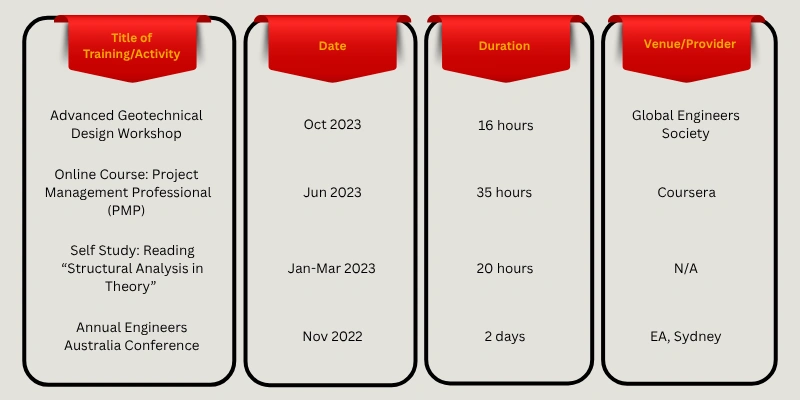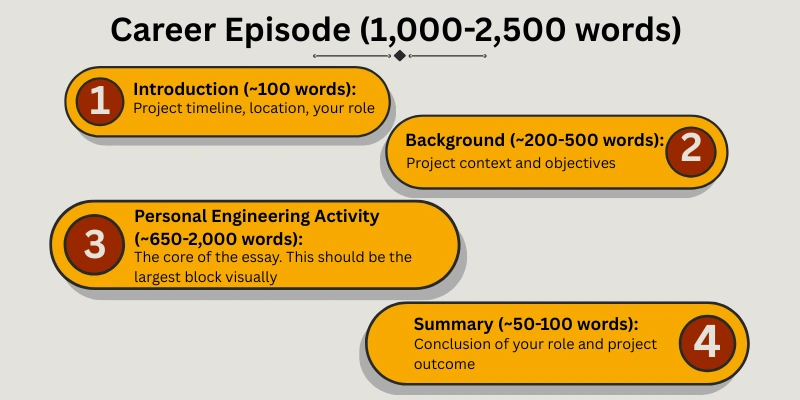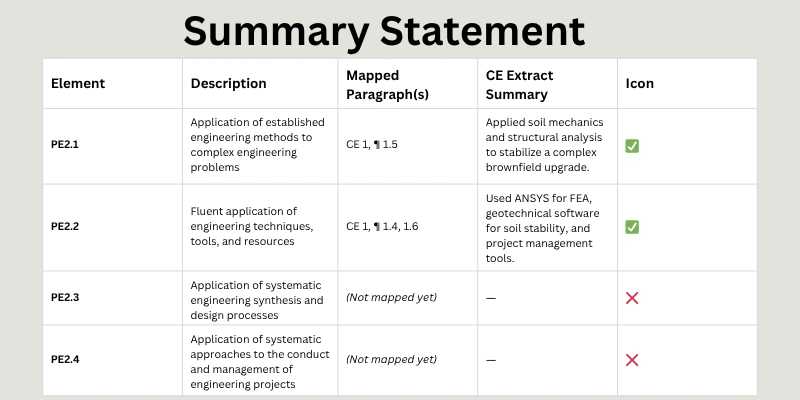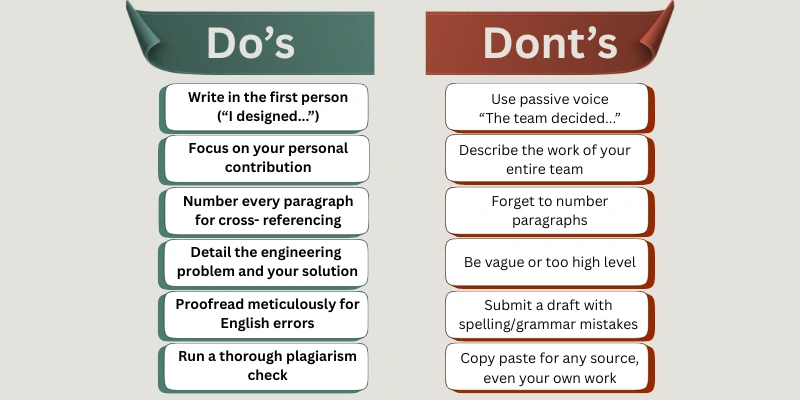The Ultimate Guide to Engineers Australia CDR Report Guidelines
Welcome to the complete guide to writing a Competency Demonstration Report (CDR) for Engineers Australia. Your goal is a successful skills assessment, and understanding the official guidelines is the first and most critical step. At TheCDRWriter, our mission is to clarify this complex process for you.
We will break down each component of the CDR based on the latest Engineers Australia Migration Skills Assessment (MSA) booklet, providing a clear framework for success. This guide streamlines the official requirements, enabling you to prepare a high-quality report ready to submit to the EA.
The Three Core Components of a CDR Report
Engineers Australia requires your CDR to be presented in a specific format, consisting of three primary documents. Your entire engineering competency is judged based on how well you prepare these.

Continuing Professional Development (CPD)
A summary of how you have kept your engineering knowledge up-to-date.

Three Career Episodes (CEs)
Three essays detailing three distinct engineering projects or problems you have worked on.

Summary Statement (SS)
The crucial one-page document that links your Career Episode activities to the specific competency elements required by Engineers Australia.
Guideline: Choosing the Right Projects for Your Career Episodes
The foundation of your Stage 1 and Stage 2 CDR writing is the projects you choose. Not all projects are created equal in the eyes of an assessor. Follow these guidelines before you start writing:
Cover a Range of Skills:
Do not choose three nearly identical projects. Your episodes should collectively showcase the full breadth of your engineering competency. Select projects that demonstrate your skills in:
- Technical design and analysis.
- Project and/or team management.
- Problem-solving and innovation.
- Communication and stakeholder management.
Demonstrate Engineering Problems:
A project where everything went perfectly is less compelling than one where you identified and solved a complex engineering problem. The assessors want to see your problem-solving methodology.
Ensure Sufficient Technical Depth:
The project must be complex enough for you to detail significant personal engineering contributions. A simple, routine task will not provide enough material to demonstrate the required competencies.

See a High-Quality CDR in Action
Understanding the components is the first step. The next step is seeing how they come together in a successful, decision-ready report. Our samples showcase the exact level of detail, formatting, and technical writing that Engineers Australia expects to see.

In-Depth Guidelines for Each Section
1. Continuing Professional Development (CPD) Guidelines
The CPD is a record of your efforts to keep current in your engineering field after completing your undergraduate degree.
Purpose
To show the assessor you are committed to your profession.
Format
This must be presented in a list format, not an essay.
What to Include
For CPD Activities for Engineers Australia, you must list the Title, Date, Duration, and Venue. Include training courses, workshops, seminars, conferences, and even periods of focused self-study.
Advanced CPD Guidelines: What a Strong CPD Looks Like
While the format is simple, the content you include makes a significant difference. An assessor uses the CPD to form their first impression of you as a professional.
Pro-Tip: How to Format Your CPD for Maximum Clarity
Instead of a simple list in a paragraph, we strongly recommend using a table. It is cleaner, more professional, and easier for the assessor to read.

Guideline: What Truly Counts as CPD?
Engineers Australia recognises a wide range of activities. You should include a mix of the following:
- Formal Education: Post-graduate courses, workshops, or training delivered by universities or professional bodies.
- On-the-Job Learning: Did you learn a new software (like ANSYS, REVIT)? Were you trained on a new industrial standard (like ISO 9001)? Did you solve a problem that required significant research? This all counts.
- Conferences and Seminars: Attending and presenting at technical conferences are both highly valuable.
- Self-Study: This is critical but often overlooked. Include:
- Reading technical books, journals (e.g., IEEE publications), and manuals.
- Watching relevant technical documentaries or online video courses.
- Receiving mentorship from a senior engineer.
- Volunteering and Leadership: Are you on a committee for a professional body? Do you mentor junior engineers? This demonstrates leadership and commitment to the profession.
Guideline on Quantity and Recency
Engineers Australia does not state a mandatory minimum number of hours, but a weak or empty CPD is a major red flag.
- Target: Aim to show at least 50 hours of professional development over the last three years.
- Recency is Key: Your CPD must be up-to-date. The majority of your listed activities should be from the past 12-24 months to show you are still actively engaged in your field. An outdated CPD suggests a lack of current knowledge.
Pro Tip: To ensure your CPD is comprehensive and professionally formatted to impress your assessor, explore our expert CPD Writing Services.
2. Career Episode (CE) Guidelines
The Career Episodes are the heart of your CDR. They are your opportunity to demonstrate your engineering skills and knowledge by detailing your contributions to specific projects.
Word Count
Each Career Episode must be between 1,000 and 2,500 words.
Language
It is mandatory to write in English and the first person singular. Use active voice, such as "I designed," "I calculated," "I analysed," and "I managed." Avoid passive phrases like "the team did" or "it was decided." The assessors need to evaluate your work, not that of your team.
Structure of Your Career Episode

The structure of your Career Episode is a critical part of the CDR format. Each Career Episode must follow this four-part structure:
- Introduction (~100 words): State the dates and duration of the project, the name of the organisation, and your job title at the time.
- Background (~200-500 words): Set the scene. Describe the nature of the engineering project, its objectives, and your role within the project team.
- Personal Engineering Activity (~650 – 2,000 words): This is the most critical section. Here, you must detail the specific tasks you performed. Describe the engineering problems you faced, the steps you took to solve them, the calculations or designs you created, and the engineering standards you applied. Be specific and focus only on your contributions.
- Summary (~50-100 words): Briefly conclude the episode by summarising your role and your contributions to the project’s outcome.
- Calculations & Analysis: Mention key calculations you performed. You don’t need to write out the full formula, but describe the input, your process, and the result. For example: “I calculated the required heat load using Fourier’s Law of Conduction, which resulted in a specification of a 50kW heating element.”
- Codes and Standards: Always mention the specific engineering standards, codes (e.g., ASME, IEEE, Eurocodes), and regulations you applied. This proves your work is professional and compliant.
- Software and Tools: Name the specific software you used for design, analysis, or project management (e.g., “I created the 3D model in SOLIDWORKS,” or “I performed finite element analysis (FEA) using ANSYS”).
- Diagrams and Tables: While not mandatory in the main text, you can refer to key diagrams or tables you created. For example: “As shown in the design schematic (Drawing A-01), I positioned the primary sensor…”
Pro Tip: Struggling to articulate your specific engineering activities? Our expert writers specialise in transforming project experience into compelling Career Episodes that meet EA’s strict standards. Reach out to us and get a free consultation for Career Episode Writing Services.
3. Summary Statement (SS) Guidelines
The Summary Statement is the final, and perhaps most complex, part of your CDR. It serves as a cross-reference, linking the competency elements defined by Engineers Australia to the specific paragraphs in your three Career Episodes where you demonstrated those competencies.

The Golden Rule:
Complete your Career Episodes before you attempt the Summary Statement.
Paragraph Numbering
You must number the paragraphs in each of your Career Episodes. For example, Career Episode 1 would have paragraphs 1.1, 1.2, 1.3, and so on. Career Episode 2 would have 2.1, 2.2, and so on.
Cross-Referencing
For each of the competency elements listed on the Summary Statement form, you must pinpoint the exact paragraph number(s) in your Career Episodes that describe that competency.
PE1
Knowledge and Skill Base: Your grasp of engineering fundamentals.
PE2
Engineering Application Ability: How you apply your knowledge to solve real-world problems. This is the most important area.
PE3
Professional and Personal Attributes: Your communication, teamwork, and management skills.
Important: The Summary Statement is where most applicants make mistakes. A single error here can lead to a negative assessment. If you are unsure about this section, consider our professional summary statement writing services.
Common Mistakes and How to Avoid Them
At TheCDRWriter, we’ve reviewed thousands of reports. Here are the most common reasons for rejection:
- Plagiarism: If you have been thinking, Is Plagiarism Allowed in CDR? Engineers Australia uses advanced software (Turnitin) to detect plagiarism. Any copied content, even from your own published papers, without proper citation, will result in an immediate rejection and a potential 12 to 36-month ban. Our service guarantees a 100% plagiarism-free report, and we can help check your work.
- Writing in Passive Voice: Using “we” or “the team” instead of “I” is a critical error. The report is about you.
- Lack of Technical Detail: Failing to explain how you solved a problem or what engineering principles you applied will weaken your report. Be specific.

Avoid Costly Mistakes and Join Our Success Stories
A single error can lead to rejection, but you don’t have to face this process alone. See how we’ve helped hundreds of engineers navigate the complexities of the CDR and achieve a positive skills assessment on their first attempt.

Rajesh K
India
⭐⭐⭐⭐⭐ 5/5
I used TheCDRWriter for my CDR writing service. The team’s understanding of Engineers Australia’s requirements was impressive. They helped me present my work experience clearly, and I received a positive assessment on the first attempt. Highly satisfied with the service.

Siti A
Sri Lanka
⭐⭐⭐⭐⭐ 4.7/5
TheCDRWriter’s RPL writing service was excellent. They carefully reviewed my qualifications and helped me structure my submission effectively. The final RPL document was tailored to meet the necessary standards, and my application was accepted.

Mohammad H
Bangladesh
⭐⭐⭐⭐⭐ 4.8/5
I was unsure whether my CDR was compliant with Engineers Australia’s guidelines. After using TheCDRWriter’s review service, I received valuable feedback that helped me refine my document. It made all the difference, and I passed the assessment process smoothly.
Therefore, when writing a CDR for Australian Immigration, avoid mistakes that may cost you your dreams! Writing your CDR is a journey that requires precision, honesty, and a deep understanding of the EA competencies. By following these guidelines, you have a clear roadmap to success. Remember, every section is an opportunity to showcase the skills you’ve worked so hard to develop.
Supporting Documents and Final Presentation
Your CDR report does not exist in a vacuum. It must be submitted as part of a complete application package.

Curriculum Vitae (CV)/Resume
Your CV is a critical supporting document. It should be detailed (typically 3 pages) and provide the career overview that your Career Episodes will later expand upon. Ensure the dates and job titles on your CV match your CDR perfectly.

English Language Test
You must provide proof of your English competency (e.g., IELTS, TOEFL, PTE). Ensure your test results are valid and meet the minimum scores required by Engineers Australia.

Official Academic Transcripts
Include scanned copies of your degree certificate and full, official academic transcripts.

File Formatting
A poorly scanned, unreadable document can lead to a negative assessment. So, make sure all documents are scanned clearly, are in PDF format, and adhere to the file size limits specified in the online application EA portal.

Final Checklist
Crafting the perfect CDR is a significant undertaking that determines the future of your engineering career in Australia. While these guidelines provide the map, the journey can be challenging.
- Are you confident that your report meets all the requirements?
- Is it 100% original and free from plagiarism?
- Does it powerfully demonstrate your engineering skills in the best possible light?
Ready to ensure your report is flawless?
Don’t leave your success to chance. The expert team at TheCDRWriter is here to ensure your report is flawless, compelling, and decision-ready. With years of relevant experience and expertise, our CDR report writers can help you write an MSA-optimised report. We are your trusted partner in achieving a positive skills assessment from Engineers Australia.
Ready to secure your future?
While this guide is comprehensive, we recommend referring to the official MSA booklet, which can be downloaded directly from the Engineers Australia website.
Frequently Asked Questions
What If My Engineering Project Is More Than Five Years Old?
While Engineers Australia prefers recent projects, older projects are acceptable if they are technically complex and significant. The key is to demonstrate your competency, regardless of the project’s age.
Can I Use My Academic Projects, Such as My Final-Year Project?
Yes, you can use one academic project, especially if you have limited work experience. However, you must focus on the engineering problem and your personal role in solving it, not just the academic requirements.
How Long Does the CDR Assessment Process by Engineers Australia Take?
While processing times vary, the standard assessment can take several months. This is why it’s crucial to submit a “decision-ready” application that is flawless to avoid delays or rejection.
How Do 'Professional Engineer' & 'Engineering Technologist' Categories Differ?
The ‘Professional Engineer’ category requires you to demonstrate competency in complex, system-level engineering problems and innovation. The ‘Engineering Technologist’ category focuses more on applying existing engineering practices and standards. We can help you choose the right category based on your experience during a free consultation.
Clear the Path to Your Professional Goals
A winning CDR is your key to the next step. Our experts work with you to create a high-impact report, complete with rigorous quality and plagiarism checks. Schedule a Free Consultation and begin your report.
